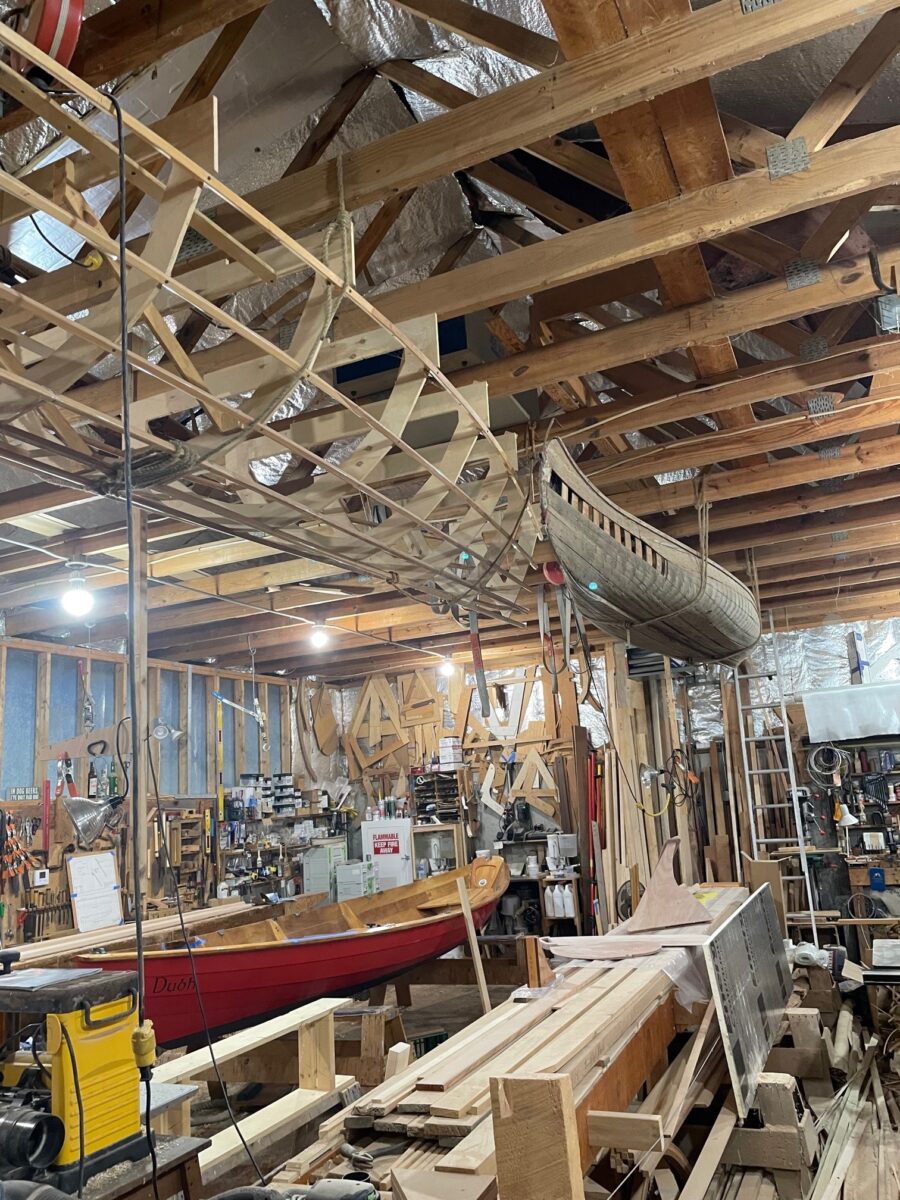
Walter Baron’s boat building shop in Wellfleet.
By Seth Rolbein
Forty years ago — that Old Testament number meant to connote a long time (raining 40 days and nights, wandering in the desert 40 years) — Walter Baron built his workshop on a side road in Wellfleet. He knew what he wanted to do, he did it, and he still does:
Build boats.
He had been working in a two-car garage around the corner but needed more room. He had the land but hadn’t built his and Jane’s home yet; the shop came first.
“It cost about 15 grand,” he remembers. “We did it in a week and a half. It had the biggest swinging doors in Wellfleet at the time, special hinges and all that.”
Now 74, he figures he has built 180 boats in that “Old Wharf Dory” shop, plenty of repairs and modifications too.
These days he works three, four, five hours a day, not eight. Before websites emerged customers came by word of mouth, still true a good bit. When people show up here’s what Walter says:
“If you’re patient, I’ll build you a good boat. I’m only doing three or four a year now, that’s all I need.”
He’s not high-end like First Light in Chatham (Building boats, building lives) or Gannon & Benjamin on the Vineyard. Baron is known for unpretentious hulls that ply near shore, prams with flat bows and flat sterns, often 16 or 17 feet, “Lumber Yard Skiffs” so-named because all materials come straight out of any decent lumberyard, no special ordering.
“The first ones I built for 1000 bucks,” he says, using spruce framing, plywood, and marine adhesive. “It took me 35 hours to build a hull.”
Every spring he’d build six prams for the Goose Hummock Shop in Orleans; they’d all vanish. He also offers an unusual option: He’ll sell his lumberyard skiff plans to anyone who wants to give him $50. He’s sent plans to New Zealand, England, Brazil, Barbados, up and down our coast. COVID inspired sales:
“Since March, 2020, I’ve sold 100 sets of plans,” more than 1500 over the years. His guess is well under half of them actually get built.
Local fishermen have made good use of his plans. Jared Bennett from Chatham remembers building his first lumberyard 16-foot skiff around 2009 or 2010, it cost around $1000 for materials “and I used it to do pretty much everything,” from taxiing to clamming:
“I remember being in waist- to chest-deep water razor clamming, and I’d throw buckets of clams on the side, jump up, put all my weight on the rail too, and never was in danger of tipping over. Incredibly stable.”
Bennett kept his first skiff in the water year-round for seven or eight years, no special protection, and when it finally needed replacing he got another set of Baron plans for the next generation.
Bill Amaru remembers building off Baron’s plans for his son Jason, both longtime commercial fishermen.
“Jason needed a decent skiff he could get out to the Joanne A-III when it was blowing too hard for the eight-foot pram,” Bill remembers. “I set up shop for skiff building, had her ready to come out in exactly one week … She is the prettiest little thing you ever laid watery eyes on.”
Jason remembers before he had his own skiff asking Jared to borrow his:
“I had a 100-pound mushroom anchor I needed to move, and when I got it in, the skiff was hardly listing to starboard at all. I was blown away at how stable it was with all that weight on one side.” So when his dad suggested building one, Jason welcomed that.
“At Walter’s strong suggestion, Dad built a mini-model first, Walter said it would save a lot of frustration when it came time to build the full version, and that worked out great,” says Jason. He thought enough of the skiff to get it fiber-glassed and jell-coated. “There’s no exposed wood anymore. That boat should last me a lifetime, probably good for my kids. That’s the kind of boat it is.”
Baron has decided to leave building lumberyard skiffs to others; they’re getting too heavy and awkward for him to manhandle solo. “The last one I did was in September, and I was swearing at it,” he laughs.
But he’s still working steadily. He has a Northeaster dory in the shop, bright red hull, a fixture on the water in the East End of Provincetown he’s converting from rowboat to sailboat. Seeing as his shop is 40-feet long, the biggest hull he’s built was 35 feet. The smallest was six and a half.
Next up?
“A 16-foot Nauset marsh skiff, that’s a fancy skiff. That’ll be the fifth one of those.” Add 50 prams completed as well.
Independent boatbuilders working in wood are, as Walter puts it, “a niche within a niche. That said, if you go to a boatbuilding school, I guarantee you’ll have a job in a minute.”
Maybe, but there aren’t many Walter Barons anymore — never were, but fewer than ever, on-Cape you can probably count them on your fingers with a few to spare.
“I’ve always worked solo,” he adds, so no long-time apprentice to step up.
He looks around the creative space of his own invention. A woodstove in the corner gets plenty of scraps to take off a chill. A pencil is at the ready, stuck under his cap over his ear. Time slows down.
Then he shrugs and smiles:
“So that’s what I’ve been up to for 40 years, man.”
(This article is built on a piece that appeared in “A Cape Cod Voice,” Seth Rolbein’s weekly online column: https://sethrolbein.substack.com/p/pram-skiff-dory-boat-builder)
